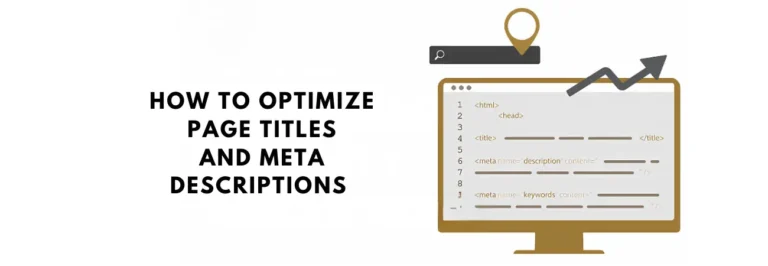In the fast-evolving world of SEO, ranking high on Google is no longer enough. To drive traffic, you must entice users to click on your link. That’s where optimized page titles and meta descriptions come into play. These two elements serve as the first impression of your webpage, influencing click-through rates (CTR) and ultimately impacting conversions.
In this guide, we’ll break down how to craft compelling titles and descriptions using proven strategies, including the ATOM framework (Analyze, Theorize, Optimize, Measure). By the end, you’ll have a clear roadmap to ensure your pages stand out in search results.

Why Page Titles & Meta Descriptions Matter for SEO
Page titles and meta descriptions aren’t just text snippets; they’re critical SEO elements that directly influence CTR. Here’s why:
Higher Rankings Don’t Guarantee Clicks – Even if you rank #1, a poorly written title won’t attract users.
Better CTR = Higher SEO Value – Google rewards pages with higher engagement, leading to sustained rankings.
User Experience (UX) & Branding – A compelling title and description create trust and set expectations.
A well-optimized title tag should:
Be between 50-60 characters to avoid truncation.
Include primary keywords naturally.
Clearly convey the value or benefit to the user.
Use power words to make it engaging.
A strong meta description should:
Be around 150-160 characters for optimal display.
Contain relevant keywords (without stuffing).
Offer a concise summary of the page’s content.
End with a call-to-action (CTA) to encourage clicks.
The ATOM Framework for Optimizing Titles & Descriptions
1. Analyze
Before making changes, audit your current page titles and meta descriptions to identify issues such as:
Truncated titles/descriptions that are cut off in search results.
Low CTR pages (check Google Search Console for insights).
Duplicate or missing meta descriptions.
Competitor analysis to see what’s working in your industry.
Tools to Use: Google Search Console, Ahrefs, SEMrush, Screaming Frog.
2. Theorize
Once you identify underperforming pages, brainstorm ways to improve their visibility. Use the SCAMPER method to refine your approach:
Substitute weak words with more engaging ones.
Combine keywords and CTAs strategically.
Adapt successful competitor strategies.
Modify structure for clarity.
Put to another use content insights from high-performing pages.
Eliminate unnecessary or redundant words.
Reverse phrasing to test variations.
3. Optimize
Now, apply these changes. Here’s how:
Use Action-Oriented Language: Instead of “Best SEO Services”, try “Boost Your Rankings with Proven SEO Strategies”.
Incorporate Power Words: Words like “Exclusive”, “Ultimate”, “Essential” attract attention.
Match Search Intent: Ensure your title aligns with what users are actually searching for.
Experiment with Brackets or Numbers: Example: “[2025 Guide] How to Rank #1 on Google”.
4. Measure
Track performance using:
Google Search Console (CTR improvements, impressions, ranking changes)
A/B Testing (Test variations of titles and descriptions to find the best-performing ones.)
Heatmaps & Click Data (See where users focus on SERPs.)
If CTR remains low, iterate and refine!
Common Mistakes to Avoid
Even the best strategies can backfire if you make these mistakes:
Keyword stuffing – Makes titles unnatural and spammy.
Clickbait tactics – Misleading descriptions hurt credibility and bounce rates.
Overly generic titles – Avoid vague phrases like “Best Services Available”.
Not optimizing for mobile users – Ensure visibility on small screens.
Case Study: SearchPilot's Meta Description Experiment
SearchPilot conducted an experiment where an e-commerce site removed meta descriptions from pages that exceeded the recommended character limit, allowing Google to generate its own snippets. The hypothesis was that Google’s autogenerated descriptions might better match user queries, leading to improved CTR. The results showed a 4.2% increase in organic sessions, suggesting that in some cases, allowing Google to create dynamic descriptions can be beneficial.
FAQs
Q1: How often should I update my page titles and meta descriptions?
It’s advisable to review and update them at least once a year or whenever there’s a significant change in content or SEO strategy.
Q2: Can I use the same meta description for multiple pages?
No, each page should have a unique meta description to avoid duplicate content issues and to provide specific information relevant to each page.
Q3: What should I do if Google rewrites my meta descriptions?
Google may rewrite meta descriptions if it deems them irrelevant to the search query. Ensure your descriptions are closely aligned with the content and target keywords to minimize this.
Q4: Do meta descriptions directly affect search rankings?
While meta descriptions don’t directly impact rankings, they influence CTR, which can affect your page’s performance in search results.
Q5: How can I test the effectiveness of my titles and descriptions?
Use A/B testing tools to experiment with different versions and monitor performance metrics like CTR in Google Search Console.
Final Thoughts: Why This Matters for 2025 & Beyond
Google is evolving, and search result real estate is more competitive than ever. Optimizing titles and descriptions isn’t just an SEO task—it’s a growth strategy. The right tweaks can mean the difference between a page that gets ignored and one that gets clicked.
Want expert help optimizing your website for maximum clicks and conversions? CG Marketing offers data-driven SEO services tailored for businesses in the UAE and beyond.
Get a free website audit today and discover how to improve your SEO performance. Contact us now to start optimizing your online presence.
